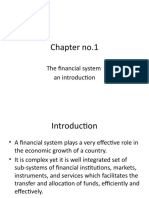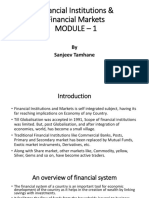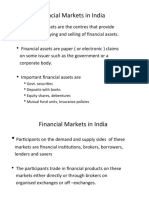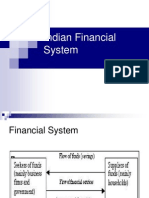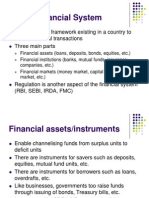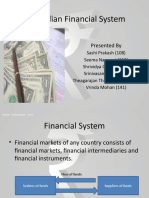0 ratings0% found this document useful (0 votes)
84 viewsOverview of Indian Financial System
Overview of Indian Financial System
Uploaded by
Dr. Meghna DangiThe document provides an overview of the Indian financial system including its key components. It discusses the three main parts of the financial system - financial assets/instruments, financial institutions, and financial markets. It then goes on to describe various financial assets/instruments, institutions like banks and mutual funds, and markets like the money market and capital market. The money market section focuses on instruments like treasury bills, commercial papers, certificates of deposits, and repo transactions.
Copyright:
© All Rights Reserved
Available Formats
Download as PPTX, PDF, TXT or read online from Scribd
Overview of Indian Financial System
Overview of Indian Financial System
Uploaded by
Dr. Meghna Dangi0 ratings0% found this document useful (0 votes)
84 views25 pagesThe document provides an overview of the Indian financial system including its key components. It discusses the three main parts of the financial system - financial assets/instruments, financial institutions, and financial markets. It then goes on to describe various financial assets/instruments, institutions like banks and mutual funds, and markets like the money market and capital market. The money market section focuses on instruments like treasury bills, commercial papers, certificates of deposits, and repo transactions.
Original Description:
Gives an overview of Indian Financial system
Copyright
© © All Rights Reserved
Available Formats
PPTX, PDF, TXT or read online from Scribd
Share this document
Did you find this document useful?
Is this content inappropriate?
The document provides an overview of the Indian financial system including its key components. It discusses the three main parts of the financial system - financial assets/instruments, financial institutions, and financial markets. It then goes on to describe various financial assets/instruments, institutions like banks and mutual funds, and markets like the money market and capital market. The money market section focuses on instruments like treasury bills, commercial papers, certificates of deposits, and repo transactions.
Copyright:
© All Rights Reserved
Available Formats
Download as PPTX, PDF, TXT or read online from Scribd
Download as pptx, pdf, or txt
0 ratings0% found this document useful (0 votes)
84 views25 pagesOverview of Indian Financial System
Overview of Indian Financial System
Uploaded by
Dr. Meghna DangiThe document provides an overview of the Indian financial system including its key components. It discusses the three main parts of the financial system - financial assets/instruments, financial institutions, and financial markets. It then goes on to describe various financial assets/instruments, institutions like banks and mutual funds, and markets like the money market and capital market. The money market section focuses on instruments like treasury bills, commercial papers, certificates of deposits, and repo transactions.
Copyright:
© All Rights Reserved
Available Formats
Download as PPTX, PDF, TXT or read online from Scribd
Download as pptx, pdf, or txt
You are on page 1of 25
Introduction to Indian Financial system
Overview of Indian Financial Markets
Financial System
• An institutional framework existing in a country to enable
financial transactions
• Three main parts
– Financial assets (loans, deposits, bonds, equities, etc.)
– Financial institutions (banks, mutual funds, insurance
companies, etc.)
– Financial markets (money market, capital market, forex market,
etc.)
• Regulation is another aspect of the financial system (RBI,
SEBI, IRDA, FMC)
Financial assets/
instruments
• Enable channelising funds from surplus units to deficit
units
• There are instruments for savers such as deposits,
equities, mutual fund units, etc.
• There are instruments for borrowers such as loans,
overdrafts, etc.
• Like businesses, governments too raise funds through
issuing of bonds, Treasury bills, etc.
• Instruments like PPF, KVP, etc. are available to savers who
wish to lend money to the government
Financial Institutions
• Includes institutions and mechanisms which
– Affect generation of savings by the community
– Mobilisation of savings
– Effective distribution of savings
• Institutions are banks, insurance companies,
mutual funds- promote/mobilise savings
• Individual investors, industrial and trading
companies- borrowers
Financial Markets
• Money Market- for short-term funds (less than
a year)
– Organised (Banks)
– Unorganised (money lenders, chit funds, etc.)
• Capital Market- for long-term funds
– Primary Issues Market
– Stock Market
– Bond Market
Organised Money Market
• Call money market
• Bill Market
– Treasury bills
– Commercial bills
• Bank loans (short-term)
• Organised money market comprises RBI,
banks (commercial and co-operative)
Purpose of the
money market
• Banks borrow in the money market to:
– Fill the gaps or temporary mismatch of funds
– To meet the CRR and SLR mandatory requirements
as stipulated by the central bank
– To meet sudden demand for funds arising out of
large outflows (like advance tax payments)
• Call money market serves the role of
equilibrating the short-term liquidity position of
the banks
Call money market (1)
• Is an integral part of the Indian money market
where day-to-day surplus funds (mostly of
banks) are traded.
• The loans are of short-term duration (1 to 14
days). Money lent for one day is called ‘call
money’; if it exceeds 1 day but is less than 15
days it is called ‘notice money’. Money lent for
more than 15 days is ‘term money’
• The borrowing is exclusively limited to banks,
who are temporarily short of funds.
Call money market (2)
• Call loans are generally made on a clean basis- i.e. no
collateral is required
• The main function of the call money market is to
redistribute the pool of day-to-day surplus funds of banks
among other banks in temporary deficit of funds
• The call market helps banks economise their cash and yet
improve their liquidity
• It is a highly competitive and sensitive market
• It acts as a good indicator of the liquidity position
Call Money Market
Participants
• Those who can both borrow and lend in the
market – RBI (through LAF), banks and primary
dealers
• Once upon a time, select financial institutions
viz., IDBI, UTI, Mutual funds were allowed in
the call money market only on the lender’s side
• These were phased out and call money market
is now a pure inter-bank market (since August
2005)
Developments in
Money Market
• Prior to mid-1980s participants depended heavily on the
call money market
• The volatile nature of the call money market led to the
activation of the Treasury Bills market to reduce
dependence on call money
• Emergence of market repo and collateralised borrowing
and lending obligation (CBLO) instruments
• Turnover in the call money market declined from Rs.
35,144 crore in 2001-02 to Rs. 14,170 crore in 2004-05
before rising to Rs. 21,725 crore in 2006-07
Bill Market
• Treasury Bill market- Also called the T-Bill market
– These bills are short-term liabilities (91-day, 182-day, 364-day) of
the Government of India
– It is an IOU of the government, a promise to pay the stated
amount after expiry of the stated period from the date of issue
– They are issued at discount to the face value and at the end of
maturity the face value is paid
– The rate of discount and the corresponding issue price are
determined at each auction
– RBI auctions 91-day T-Bills on a weekly basis, 182-day T-Bills and
364-day T-Bills on a fortnightly basis on behalf of the central
government
Money Market
Instruments1)
• Money market instruments are those which
have maturity period of less than one year.
• The most active part of the money market is
the market for overnight call and term money
between banks and institutions and repo
transactions
• Call money/repo are very short-term money
market products
Money Market Instruments
• Certificates of Deposit
• Commercial Paper
• Inter-bank participation certificates
• Inter-bank term money
• Treasury Bills
• Bill rediscounting
• Call/notice/term money
• CBLO
• Market Repo
Certificates of Deposit
• CDs are short-term borrowings in the form of UPN issued by all
scheduled banks and are freely transferable by endorsement and
delivery.
• Introduced in 1989
• Maturity of not less than 7 days and maximum up to a year. FIs are
allowed to issue CDs for a period between 1 year and up to 3 years
• Subject to payment of stamp duty under the Indian Stamp Act, 1899
• Issued to individuals, corporations, trusts, funds and associations
• They are issued at a discount rate freely determined by the
market/investors
Commercial Papers
• Short-term borrowings by corporates, financial institutions, primary
dealers from the money market
• Can be issued in the physical form (Usance Promissory Note) or demat
form
• Introduced in 1990
• When issued in physical form are negotiable by endorsement and
delivery and hence, highly flexible
• Issued subject to minimum of Rs. 5 lacs and in the multiple of Rs. 5 lacs
after that
• Maturity is 7 days to 1 year
• Unsecured and backed by credit rating of the issuing company
• Issued at discount to the face value
Market Repos
• Repo (repurchase agreement) instruments enable
collateralised short-term borrowing through the selling
of debt instruments
• A security is sold with an agreement to repurchase it at a
pre-determined date and rate
• Reverse repo is a mirror image of repo and reflects the
acquisition of a security with a simultaneous
commitment to resell
• Average daily turnover of repo transactions (other than
the Reserve Bank) increased from Rs.11,311 crore during
April 2001 to Rs. 42,252 crore in June 2006
Collateralised Borrowing and
Lending Obligation (CBLO)
• Operationalised as money market instruments by the
CCIL in 2003
• Follows an anonymous, order-driven and online trading
system
• On the lenders side main participants are mutual funds,
insurance companies.
• Major borrowers are nationalised banks, PDs and non-
financial companies
• The average daily turnover in the CBLO segment
increased from Rs. 515 crore (2003-04) to Rs. 32, 390
crore (2006-07)
Indian Capital Market
• Market for long-term capital. Demand comes
from the industrial, service sector and
government
• Supply comes from individuals, corporates,
banks, financial institutions, etc.
• Can be classified into:
– Gilt-edged market
– Industrial securities market (new issues and stock
market)
• Development Financial Institutions
– Industrial Finance Corporation of India (IFCI)
– State Finance Corporations (SFCs)
– Industrial Development Finance Corporation (IDFC)
• Financial Intermediaries
– Merchant Banks
– Mutual Funds
– Leasing Companies
– Venture Capital Companies
Corporate Securities Market
• Refers to the market for shares and
debentures of old and new companies
• New Issues Market- also known as the primary
market- refers to raising of new capital in the
form of shares and debentures
• Stock Market- also known as the secondary
market. Deals with securities already issued by
companies
Financial Intermediaries (1)
• Mutual Funds- Promote savings and mobilise funds
which are invested in the stock market and bond market
• Indirect source of finance to companies
• Pool funds of savers and invest in the stock market/bond
market
• Their instruments at saver’s end are called units
• Offer many types of schemes: growth fund, income fund,
balanced fund
• Regulated by SEBI
• Merchant banking- manage and underwrite new issues,
undertake syndication of credit, advise corporate clients
on fund raising
• Subject to regulation by SEBI and RBI
• SEBI regulates them on issue activity and portfolio
management of their business.
• RBI supervises those merchant banks which are
subsidiaries or affiliates of commercial banks
• Have to adopt stipulated capital adequacy norms and
abide by a code of conduct
Conclusion
• There are other financial intermediaries such as
NBFCs, Venture Capital Funds, Hire and Leasing
Companies, etc.
• India’s financial system is quite huge and caters
to every kind of demand for funds
• Banks are at the core of our financial system
and therefore, there is greater expectation from
them in terms of reaching out to the vast
populace as well as being competitive.
Assignment
• https://
www.youtube.com/watch?v=d_xqhSD44gY
• https://
www.youtube.com/watch?v=AFxyTWg_gqY
• https://www.youtube.com/watch?v=-
ZGIN1wLux4
• https://www.youtube.com/watch?v=hid_sZUL
IqU
You might also like
- BitCoin White PaperDocument9 pagesBitCoin White PaperZX Lee100% (4)
- Indian Financial SystemDocument53 pagesIndian Financial SystemSiddharth BansalNo ratings yet
- IFS 2023-24-newDocument48 pagesIFS 2023-24-newnehasp1503No ratings yet
- Money Market: Dr. Divya Asst. Prof., USMS, GGSIPUDocument27 pagesMoney Market: Dr. Divya Asst. Prof., USMS, GGSIPUHarsh PrakashNo ratings yet
- Financial System: - An Institutional Framework Existing in A Country To Enable Financial Transactions - Three Main PartsDocument10 pagesFinancial System: - An Institutional Framework Existing in A Country To Enable Financial Transactions - Three Main PartsOmkarpratim MitraNo ratings yet
- Indian Fixed Income MarketDocument27 pagesIndian Fixed Income MarketNitesh GoyalNo ratings yet
- Indian Financial Markets: Class of MBADocument43 pagesIndian Financial Markets: Class of MBAaksid1No ratings yet
- Unit 1Document64 pagesUnit 1Suneel KumarNo ratings yet
- Chapter No.1: The Financial System An IntroductionDocument19 pagesChapter No.1: The Financial System An IntroductionChavda BhaveshNo ratings yet
- Finance Specilization: Asst. Professors, MBA Department, Bhagawan Mahavir College of Management, SuratDocument85 pagesFinance Specilization: Asst. Professors, MBA Department, Bhagawan Mahavir College of Management, Suratpravesh malikNo ratings yet
- Indian Financial SystemDocument40 pagesIndian Financial SystemArun SarkarNo ratings yet
- Management of Financial Services: Finance SpecilizationDocument83 pagesManagement of Financial Services: Finance SpecilizationaamirankNo ratings yet
- Indian Financial SystemDocument39 pagesIndian Financial Systempoojaguptainida1No ratings yet
- FMBODocument10 pagesFMBOHimani ChavanNo ratings yet
- Finance Specilization: Asst. Professors, MBA Department, Bhagawan Mahavir College of Management, SuratDocument85 pagesFinance Specilization: Asst. Professors, MBA Department, Bhagawan Mahavir College of Management, Suratsakshirelan87No ratings yet
- MGMT 102 - Module - 3Document13 pagesMGMT 102 - Module - 3shubhangiverma2005No ratings yet
- Money Market's InstrumentsDocument20 pagesMoney Market's InstrumentsManmohan Prasad RauniyarNo ratings yet
- Money Market: Security Analysis and Portfolio ManagementDocument23 pagesMoney Market: Security Analysis and Portfolio Managementrahu007einstein56uNo ratings yet
- Indian Financial SystemDocument17 pagesIndian Financial SystemMohsin KhanNo ratings yet
- Abhishek Chaudhary Jatinder Dangwal Nupur Jain Ravinder Sharma Rishi Panwar Sakshi Chauhan Shashi Kumar Shankar Narayan BatabyalDocument41 pagesAbhishek Chaudhary Jatinder Dangwal Nupur Jain Ravinder Sharma Rishi Panwar Sakshi Chauhan Shashi Kumar Shankar Narayan BatabyalSakshi ChauhanNo ratings yet
- Summer Placement at IFCDocument20 pagesSummer Placement at IFCCrazytoonagainNo ratings yet
- CH 2 Indian Financial SystemDocument46 pagesCH 2 Indian Financial Systemmaheshbendigeri5945No ratings yet
- Constituents of The Financial System DD Intro NewDocument17 pagesConstituents of The Financial System DD Intro NewAnonymous bf1cFDuepPNo ratings yet
- Money Market by TanishaDocument15 pagesMoney Market by TanishakirtikaNo ratings yet
- Developing The Money Market in India: Dr. Muhammad ShafiDocument40 pagesDeveloping The Money Market in India: Dr. Muhammad ShafiPradeep KumarNo ratings yet
- Money MarketDocument27 pagesMoney MarketThe State AcademyNo ratings yet
- Financial Institutions & Financial Markets Module - 1: by Sanjeev TamhaneDocument35 pagesFinancial Institutions & Financial Markets Module - 1: by Sanjeev TamhaneSwagatJagtapNo ratings yet
- Financial Markets in IndiaDocument26 pagesFinancial Markets in Indiatadpelliwar_navinNo ratings yet
- Indian Financial SystemDocument42 pagesIndian Financial SystemPunam Dandekar SalviNo ratings yet
- IBE Module 6Document29 pagesIBE Module 6Prathik_Shetty_204No ratings yet
- Indian Financial System Chapter 1Document16 pagesIndian Financial System Chapter 1Rahul GhosaleNo ratings yet
- Institutional FinanaceDocument29 pagesInstitutional Finanaceradhika77799No ratings yet
- FALLSEM2020-21 CCA2705 TH VL2020210101345 Reference Material III 14-Jul-2020 FINANCIAL MARKETS Module 2 5Document40 pagesFALLSEM2020-21 CCA2705 TH VL2020210101345 Reference Material III 14-Jul-2020 FINANCIAL MARKETS Module 2 5Jayagokul SaravananNo ratings yet
- Money Market and Its InstrumentsDocument22 pagesMoney Market and Its InstrumentsRajat SinghNo ratings yet
- Financial System - IntroductionDocument31 pagesFinancial System - IntroductionVaidyanathan RavichandranNo ratings yet
- Financial System: An Institutional Framework Existing in A Country To Enable Financial Transactions Three Main PartsDocument23 pagesFinancial System: An Institutional Framework Existing in A Country To Enable Financial Transactions Three Main PartsManas MishraNo ratings yet
- Instruments in Treasury MarketDocument34 pagesInstruments in Treasury MarketsupriyabhadoriyaNo ratings yet
- Indianfinancialsystem 120211233627 Phpapp02Document57 pagesIndianfinancialsystem 120211233627 Phpapp02lalitNo ratings yet
- Money MarketDocument25 pagesMoney MarketVaidyanathan RavichandranNo ratings yet
- Study Material On Money MarketDocument25 pagesStudy Material On Money MarketPrateek VyasNo ratings yet
- FM - Indian Financial SystemDocument70 pagesFM - Indian Financial SystemRubal GangulyNo ratings yet
- Day 3Document66 pagesDay 3utkarshNo ratings yet
- JAIIB (Module A) : Indian Financial SystemDocument40 pagesJAIIB (Module A) : Indian Financial SystemSwaraj PurohitNo ratings yet
- Class 1-Indian Financial SystemDocument47 pagesClass 1-Indian Financial SystembitturajaNo ratings yet
- Financial Services ManagementDocument43 pagesFinancial Services ManagementChandan ParsadNo ratings yet
- CH 2 Indian Financial SystemDocument46 pagesCH 2 Indian Financial SystemAkshay AhirNo ratings yet
- Money MarketDocument21 pagesMoney MarketanuradhaNo ratings yet
- Money Market and Capital MarketsDocument18 pagesMoney Market and Capital MarketsAditi KulkarniNo ratings yet
- An Overview of Indian Financial SystemDocument39 pagesAn Overview of Indian Financial SystemPankaj AgriNo ratings yet
- Module 10 Financial MarketsDocument61 pagesModule 10 Financial Marketsg.prasanna saiNo ratings yet
- UNIT III Indian Financial SystemDocument80 pagesUNIT III Indian Financial SystemvishuuashuuNo ratings yet
- Tfis Chapter IDocument70 pagesTfis Chapter IShashank shekharNo ratings yet
- Money Market Participants & InstrumentsDocument24 pagesMoney Market Participants & InstrumentsManpreet SethiNo ratings yet
- Indian Financial SystemDocument57 pagesIndian Financial SystemRanjeet RajputNo ratings yet
- CFA level 1: 2025 Equity Investments: CFA level 1, #2From EverandCFA level 1: 2025 Equity Investments: CFA level 1, #2Rating: 5 out of 5 stars5/5 (1)
- A Practical Approach to the Study of Indian Capital MarketsFrom EverandA Practical Approach to the Study of Indian Capital MarketsNo ratings yet
- Ind As 1, 7,8,10, 34Document40 pagesInd As 1, 7,8,10, 34Dr. Meghna DangiNo ratings yet
- Activity: - Make A List ofDocument15 pagesActivity: - Make A List ofDr. Meghna DangiNo ratings yet
- Science of Living - 2: Core ValuesDocument16 pagesScience of Living - 2: Core ValuesDr. Meghna DangiNo ratings yet
- Core Value Sincerity Week 2Document8 pagesCore Value Sincerity Week 2Dr. Meghna DangiNo ratings yet
- Overview of Co-Operative BankingDocument14 pagesOverview of Co-Operative BankingDr. Meghna DangiNo ratings yet
- Entrepreneurial SpectrumDocument13 pagesEntrepreneurial SpectrumDr. Meghna DangiNo ratings yet
- BPI vs. Ulrich Forester G.R. No. L-25811Document1 pageBPI vs. Ulrich Forester G.R. No. L-25811Xander 4thNo ratings yet
- 9 Revision OADocument12 pages9 Revision OASaeed MahmoodNo ratings yet
- Tax Rebate 80ccf Ifci Long Term Infra BondDocument62 pagesTax Rebate 80ccf Ifci Long Term Infra BondInvestmentstartegy TipsNo ratings yet
- BanksDocument50 pagesBanksErutangisrg 1995No ratings yet
- Landbank v. Oñate G.R. No. 192371 January 15 2014Document3 pagesLandbank v. Oñate G.R. No. 192371 January 15 2014Tootsie GuzmaNo ratings yet
- Basel Committee & Basel Norms: Presented By-Yasha Singh 4113007007Document20 pagesBasel Committee & Basel Norms: Presented By-Yasha Singh 4113007007Vaishali Trivedi OjhaNo ratings yet
- Options Trading StrategiesDocument27 pagesOptions Trading Strategieskanabaramit67% (3)
- Candidates Are Required To Give Their Answers in Their Own Words As Far As Practicable. The Figures in The Margin Indicate Full MarksDocument2 pagesCandidates Are Required To Give Their Answers in Their Own Words As Far As Practicable. The Figures in The Margin Indicate Full MarksGyan PokhrelNo ratings yet
- Ministry of Corporate Affairs - MCA ServicesDocument2 pagesMinistry of Corporate Affairs - MCA ServicesMeiyappan MNo ratings yet
- Reporting AddendumDocument19 pagesReporting AddendumthtengNo ratings yet
- Course in Financial Accounting Using TallyDocument2 pagesCourse in Financial Accounting Using TallyCABA MDTP CourseNo ratings yet
- FbsDocument10 pagesFbsPrince Matthew NatanawanNo ratings yet
- EStatements 3Document4 pagesEStatements 3johnnychristopher199No ratings yet
- CFMS PaymentsDocument15 pagesCFMS PaymentsU. RamakrishnaNo ratings yet
- Yadavindra Public School, S.A.S. Nagar (Mohali) Holiday HomeworkDocument4 pagesYadavindra Public School, S.A.S. Nagar (Mohali) Holiday HomeworkAnasNo ratings yet
- Statement of Axis Account No:917010078961373 For The Period (From: 16-01-2023 To: 15-02-2023)Document2 pagesStatement of Axis Account No:917010078961373 For The Period (From: 16-01-2023 To: 15-02-2023)philipsjjNo ratings yet
- Annual Report 2014 enDocument310 pagesAnnual Report 2014 enMohammad AldehneeNo ratings yet
- UntitledDocument12 pagesUntitledKhusnul 23No ratings yet
- Global Transaction Service Acronym GuideDocument8 pagesGlobal Transaction Service Acronym GuideBarun KumarNo ratings yet
- Essay 2024Document6 pagesEssay 20244th zenz starNo ratings yet
- MTBiz April-2017 PDFDocument28 pagesMTBiz April-2017 PDFKhandaker Amir EntezamNo ratings yet
- Albert Financial Plan FinalDocument16 pagesAlbert Financial Plan FinalJason TehNo ratings yet
- Paying Off DebtDocument12 pagesPaying Off DebtSnowdenKonanNo ratings yet
- FM-Math, Time Value of MoneyDocument2 pagesFM-Math, Time Value of Moneymaher213No ratings yet
- Roman Frydman KeynoteDocument9 pagesRoman Frydman KeynoteEric WhitfieldNo ratings yet
- Establish and Maintain Accural Accounting System AdmaDocument34 pagesEstablish and Maintain Accural Accounting System Admaeliyas mohammedNo ratings yet
- New Balance $6,595.66 Minimum Payment Due $1,646.00 Payment Due Date 01/08/23Document5 pagesNew Balance $6,595.66 Minimum Payment Due $1,646.00 Payment Due Date 01/08/23Rahul Sharma Ji0% (1)
- ICICIBankDocument446 pagesICICIBankJagannath DNo ratings yet
- Factoring, Bill Discounting, ForfeitingDocument70 pagesFactoring, Bill Discounting, ForfeitingMadhavi Reddy80% (5)








